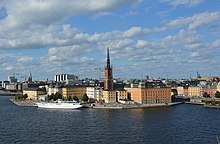Architecture of Stockholm
[1] According to some sources, there might have been a simple defense structure, perhaps a small castle, on the northeast part of the island Stadsholmen.
Stockholm's historic buildings are largely conserved because the city has escaped destruction through war, which was commonplace in Europe.
Stockholm is first mentioned as the capital of Sweden in the 1430s, though the city existed for over 200 years prior to that and had become a typical Hansa port.
The 14th century saw King Magnus's disputes with the Danish provinces of Skåne and Blekinge leading to attacks on Swedish cities, including Stockholm.
This was a period in which Stockholm, as it had only recently been referred to, moved between the bridges surrounding Gamla stan's structure for security.
[2] Stockholm's development was also especially influenced by Germany because of the great volume of trade occurring between the nations at the time through the nearby waterways.
[3] King Gustav Vasa rose to power as a result of the dispute and declared the city an independent monarchy.


